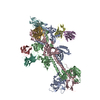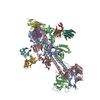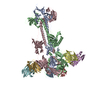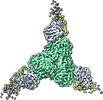[English] 日本語
 Yorodumi
Yorodumi- EMDB-19165: Trimeric HSV-2F gB ectodomain in postfusion conformation with thr... -
+ Open data
Open data
- Basic information
Basic information
| Entry |  | |||||||||
|---|---|---|---|---|---|---|---|---|---|---|
| Title | Trimeric HSV-2F gB ectodomain in postfusion conformation with three bound HDIT101 Fab molecules. | |||||||||
 Map data Map data | main map | |||||||||
 Sample Sample |
| |||||||||
 Keywords Keywords | ectodomain / post-fusion / fab molecule / trimeric / VIRAL PROTEIN | |||||||||
| Function / homology |  Function and homology information Function and homology informationhost cell endosome / host cell Golgi apparatus / symbiont entry into host cell / viral envelope / virion attachment to host cell / host cell plasma membrane / membrane Similarity search - Function | |||||||||
| Biological species |  Homo sapiens (human) / Homo sapiens (human) /  Human herpesvirus 2 strain G Human herpesvirus 2 strain G | |||||||||
| Method | single particle reconstruction / cryo EM / Resolution: 3.45 Å | |||||||||
 Authors Authors | Kalbermatter D / Seyfizadeh N / Imhof T / Ries M / Mueller C / Jenner L / Blumenschein E / Yendrzheyevskiy A / Moog K / Eckert D ...Kalbermatter D / Seyfizadeh N / Imhof T / Ries M / Mueller C / Jenner L / Blumenschein E / Yendrzheyevskiy A / Moog K / Eckert D / Engel R / Diebolder P / Chami M / Krauss J / Schaller T / Arndt M | |||||||||
| Funding support |  Germany, 1 items Germany, 1 items
| |||||||||
 Citation Citation |  Journal: J Biomed Sci / Year: 2024 Journal: J Biomed Sci / Year: 2024Title: Development of a highly effective combination monoclonal antibody therapy against Herpes simplex virus. Authors: Narges Seyfizadeh / David Kalbermatter / Thomas Imhof / Moritz Ries / Christian Müller / Leonie Jenner / Elisabeth Blumenschein / Alexandra Yendrzheyevskiy / Frank Grün / Kevin Moog / ...Authors: Narges Seyfizadeh / David Kalbermatter / Thomas Imhof / Moritz Ries / Christian Müller / Leonie Jenner / Elisabeth Blumenschein / Alexandra Yendrzheyevskiy / Frank Grün / Kevin Moog / Daniel Eckert / Ronja Engel / Philipp Diebolder / Mohamed Chami / Jürgen Krauss / Torsten Schaller / Michaela Arndt /   Abstract: BACKGROUND: Infections with Herpes simplex virus (HSV)-1 or -2 usually present as mild chronic recurrent disease, however in rare cases can result in life-threatening conditions with a large spectrum ...BACKGROUND: Infections with Herpes simplex virus (HSV)-1 or -2 usually present as mild chronic recurrent disease, however in rare cases can result in life-threatening conditions with a large spectrum of pathology. Monoclonal antibody therapy has great potential especially to treat infections with virus resistant to standard therapies. HDIT101, a humanized IgG targeting HSV-1/2 gB was previously investigated in phase 2 clinical trials. The aim of this study was to develop a next-generation therapy by combining different antiviral monoclonal antibodies. METHODS: A lymph-node derived phage display library (LYNDAL) was screened against recombinant gB from Herpes simplex virus (HSV) -1 and HDIT102 scFv was selected for its binding characteristics using ...METHODS: A lymph-node derived phage display library (LYNDAL) was screened against recombinant gB from Herpes simplex virus (HSV) -1 and HDIT102 scFv was selected for its binding characteristics using bio-layer interferometry. HDIT102 was further developed as fully human IgG and tested alone or in combination with HDIT101, a clinically tested humanized anti-HSV IgG, in vitro and in vivo. T-cell stimulating activities by antigen-presenting cells treated with IgG-HSV immune complexes were analyzed using primary human cells. To determine the epitopes, the cryo-EM structures of HDIT101 or HDIT102 Fab bound to HSV-1F as well as HSV-2G gB protein were solved at resolutions < 3.5 Å. RESULTS: HDIT102 Fab showed strong binding to HSV-1F gB with Kd of 8.95 × 10 M and to HSV-2G gB with Kd of 3.29 × 10 M. Neutralization of cell-free virus and inhibition of cell-to-cell ...RESULTS: HDIT102 Fab showed strong binding to HSV-1F gB with Kd of 8.95 × 10 M and to HSV-2G gB with Kd of 3.29 × 10 M. Neutralization of cell-free virus and inhibition of cell-to-cell spread were comparable between HDIT101 and HDIT102. Both antibodies induced internalization of gB from the cell surface into acidic endosomes by binding distinct epitopes in domain I of gB and compete for binding. CryoEM analyses revealed the ability to form heterogenic immune complexes consisting of two HDIT102 and one HDIT101 Fab bound to one gB trimeric molecule. Both antibodies mediated antibody-dependent phagocytosis by antigen presenting cells which stimulated autologous T-cell activation. In vivo, the combination of HDIT101 and HDIT102 demonstrated synergistic effects on survival and clinical outcome in immunocompetent BALB/cOlaHsd mice. CONCLUSION: This biochemical and immunological study showcases the potential of an effective combination therapy with two monoclonal anti-gB IgGs for the treatment of HSV-1/2 induced disease conditions. | |||||||||
| History |
|
- Structure visualization
Structure visualization
| Supplemental images |
|---|
- Downloads & links
Downloads & links
-EMDB archive
| Map data |  emd_19165.map.gz emd_19165.map.gz | 7.5 MB |  EMDB map data format EMDB map data format | |
|---|---|---|---|---|
| Header (meta data) |  emd-19165-v30.xml emd-19165-v30.xml emd-19165.xml emd-19165.xml | 21.9 KB 21.9 KB | Display Display |  EMDB header EMDB header |
| FSC (resolution estimation) |  emd_19165_fsc.xml emd_19165_fsc.xml | 10.6 KB | Display |  FSC data file FSC data file |
| Images |  emd_19165.png emd_19165.png | 69.2 KB | ||
| Masks |  emd_19165_msk_1.map emd_19165_msk_1.map | 103 MB |  Mask map Mask map | |
| Filedesc metadata |  emd-19165.cif.gz emd-19165.cif.gz | 7 KB | ||
| Others |  emd_19165_half_map_1.map.gz emd_19165_half_map_1.map.gz emd_19165_half_map_2.map.gz emd_19165_half_map_2.map.gz | 80.7 MB 80.7 MB | ||
| Archive directory |  http://ftp.pdbj.org/pub/emdb/structures/EMD-19165 http://ftp.pdbj.org/pub/emdb/structures/EMD-19165 ftp://ftp.pdbj.org/pub/emdb/structures/EMD-19165 ftp://ftp.pdbj.org/pub/emdb/structures/EMD-19165 | HTTPS FTP |
-Validation report
| Summary document |  emd_19165_validation.pdf.gz emd_19165_validation.pdf.gz | 791.1 KB | Display |  EMDB validaton report EMDB validaton report |
|---|---|---|---|---|
| Full document |  emd_19165_full_validation.pdf.gz emd_19165_full_validation.pdf.gz | 790.6 KB | Display | |
| Data in XML |  emd_19165_validation.xml.gz emd_19165_validation.xml.gz | 17.8 KB | Display | |
| Data in CIF |  emd_19165_validation.cif.gz emd_19165_validation.cif.gz | 23.7 KB | Display | |
| Arichive directory |  https://ftp.pdbj.org/pub/emdb/validation_reports/EMD-19165 https://ftp.pdbj.org/pub/emdb/validation_reports/EMD-19165 ftp://ftp.pdbj.org/pub/emdb/validation_reports/EMD-19165 ftp://ftp.pdbj.org/pub/emdb/validation_reports/EMD-19165 | HTTPS FTP |
-Related structure data
| Related structure data |  8rh1MC  8rgzC  8rh0C  8rh2C C: citing same article ( M: atomic model generated by this map |
|---|---|
| Similar structure data | Similarity search - Function & homology  F&H Search F&H Search |
- Links
Links
| EMDB pages |  EMDB (EBI/PDBe) / EMDB (EBI/PDBe) /  EMDataResource EMDataResource |
|---|
- Map
Map
| File |  Download / File: emd_19165.map.gz / Format: CCP4 / Size: 103 MB / Type: IMAGE STORED AS FLOATING POINT NUMBER (4 BYTES) Download / File: emd_19165.map.gz / Format: CCP4 / Size: 103 MB / Type: IMAGE STORED AS FLOATING POINT NUMBER (4 BYTES) | ||||||||||||||||||||
|---|---|---|---|---|---|---|---|---|---|---|---|---|---|---|---|---|---|---|---|---|---|
| Annotation | main map | ||||||||||||||||||||
| Voxel size | X=Y=Z: 1.28871 Å | ||||||||||||||||||||
| Density |
| ||||||||||||||||||||
| Symmetry | Space group: 1 | ||||||||||||||||||||
| Details | EMDB XML:
|
-Supplemental data
-Mask #1
| File |  emd_19165_msk_1.map emd_19165_msk_1.map | ||||||||||||
|---|---|---|---|---|---|---|---|---|---|---|---|---|---|
| Projections & Slices |
| ||||||||||||
| Density Histograms |
-Half map: half map 1
| File | emd_19165_half_map_1.map | ||||||||||||
|---|---|---|---|---|---|---|---|---|---|---|---|---|---|
| Annotation | half map 1 | ||||||||||||
| Projections & Slices |
| ||||||||||||
| Density Histograms |
-Half map: half map 1
| File | emd_19165_half_map_2.map | ||||||||||||
|---|---|---|---|---|---|---|---|---|---|---|---|---|---|
| Annotation | half map 1 | ||||||||||||
| Projections & Slices |
| ||||||||||||
| Density Histograms |
- Sample components
Sample components
-Entire : Trimeric HSV-2G gB ectodomain in post-fusion conformation with th...
| Entire | Name: Trimeric HSV-2G gB ectodomain in post-fusion conformation with three bound HDIT101 Fab molecules |
|---|---|
| Components |
|
-Supramolecule #1: Trimeric HSV-2G gB ectodomain in post-fusion conformation with th...
| Supramolecule | Name: Trimeric HSV-2G gB ectodomain in post-fusion conformation with three bound HDIT101 Fab molecules type: complex / ID: 1 / Parent: 0 / Macromolecule list: all |
|---|---|
| Source (natural) | Organism:  Homo sapiens (human) Homo sapiens (human) |
| Molecular weight | Theoretical: 523 KDa |
-Macromolecule #1: Envelope glycoprotein B
| Macromolecule | Name: Envelope glycoprotein B / type: protein_or_peptide / ID: 1 / Number of copies: 3 / Enantiomer: LEVO |
|---|---|
| Source (natural) | Organism:  Human herpesvirus 2 strain G Human herpesvirus 2 strain G |
| Molecular weight | Theoretical: 79.378227 KDa |
| Recombinant expression | Organism:  Homo sapiens (human) Homo sapiens (human) |
| Sequence | String: AAPAAPRASG GVAATVAANG GPASRPPPVP SPATTRARKR KTKKPPERPE ATPPPDANAT VAAGHATLRA HLREIKVENA DAQFYVCPP PTGATVVQFE QPRRCPTRPE GQNYTEGIAV VFKENIAPYK FKATMYYKDV TVSQVWFGHR YSQFMGIFED R APVPFEEV ...String: AAPAAPRASG GVAATVAANG GPASRPPPVP SPATTRARKR KTKKPPERPE ATPPPDANAT VAAGHATLRA HLREIKVENA DAQFYVCPP PTGATVVQFE QPRRCPTRPE GQNYTEGIAV VFKENIAPYK FKATMYYKDV TVSQVWFGHR YSQFMGIFED R APVPFEEV IDKINAKGVC RSTAKYVRNN METTAFHRDD HETDMELKPA KVATRTSRGW HTTDLKYNPS RVEAFHRYGT TV NCIVEEV DARSVYPYDE FVLATGDFVY MSPFYGYREG SHTEHTSYAA DRFKQVDGFY ARDLTTKARA TSPTTRNLLT TPK FTVAWD WVPKRPAVCT MTKWQEVDEM LRAEYGGSFR FSSDAISTTF TTNLTQYSLS RVDLGDCIGR DAREAIDRMF ARKY NATHI KVGQPQYYLA TGGFLIAYQP LLSNTLAELY VREYMREQDR KPRNATPAPL REAPSANASV ERIKTTSSIE FARLQ FTYN HIQRHVNDML GRIAVAWCEL QNHELTLWNE ARKLNPNAIA SATVGRRASA RMLGDVMAVS TCVPVAPDNV IVQNSM RVS SRPGTCYSRP LVSFRYEDQG PLIEGQLGEN NELRLTRDAL EPCTVGHRRY FIFGGGYVYF EEYAYSHQLS RADVTTV ST FIDLNITMLE DHEFVPLEVY TRHEIKDSGL LDYTEVQRRN QLHDLRFADI DTVIRADANA A UniProtKB: Envelope glycoprotein B |
-Macromolecule #2: HDIT101 Fab heavy chain
| Macromolecule | Name: HDIT101 Fab heavy chain / type: protein_or_peptide / ID: 2 / Number of copies: 3 / Enantiomer: LEVO |
|---|---|
| Source (natural) | Organism:  Homo sapiens (human) Homo sapiens (human) |
| Molecular weight | Theoretical: 49.676211 KDa |
| Recombinant expression | Organism:  Homo sapiens (human) Homo sapiens (human) |
| Sequence | String: TLKESGPALV KPTQTLTLTC TFSGFSLSTS GMSVGWIRQP PGKALEWLAH IWWNNDKYYK PALKSRLTIS KDTSKNQVVL TMTNMDPVD TATYYCARIY YGYRPYAMDY WGQGTLVTVS SASTKGPSVF PLAPSSKSTS GGTAALGCLV KDYFPEPVTV S WNSGALTS ...String: TLKESGPALV KPTQTLTLTC TFSGFSLSTS GMSVGWIRQP PGKALEWLAH IWWNNDKYYK PALKSRLTIS KDTSKNQVVL TMTNMDPVD TATYYCARIY YGYRPYAMDY WGQGTLVTVS SASTKGPSVF PLAPSSKSTS GGTAALGCLV KDYFPEPVTV S WNSGALTS GVHTFPAVLQ SSGLYSLSSV VTVPSSSLGT QTYICNVNHK PSNTKVDKKV EPKSCDKTHT CPPCPAPELL GG PSVFLFP PKPKDTLMIS RTPEVTCVVV DVSHEDPEVK FNWYVDGVEV HNAKTKPREE QYNSTYRVVS VLTVLHQDWL NGK EYKCKV SNKALPAPIE KTISKAKGQP REPQVYTLPP SRDELTKNQV SLTCLVKGFY PSDIAVEWES NGQPENNYKT TPPV LDSDG SFFLYSKLTV DKSRWQQGNV FSCSVMHEAL HNHYTQKSLS LSPGK |
-Macromolecule #3: HDIT101 Fab light chain
| Macromolecule | Name: HDIT101 Fab light chain / type: protein_or_peptide / ID: 3 / Number of copies: 3 / Enantiomer: LEVO |
|---|---|
| Source (natural) | Organism:  Homo sapiens (human) Homo sapiens (human) |
| Molecular weight | Theoretical: 23.944691 KDa |
| Recombinant expression | Organism:  Homo sapiens (human) Homo sapiens (human) |
| Sequence | String: IVMTQTPLSL PVTPGEPASI SCRSSQSIVH SNGNTYLEWY LQKPGQSPQL LIYKVSNRFS GVPDRFSGSG SGTDFTLKIS RVEAEDVGV YYCFQGSHVP WSFGQGTKLE IKRTVAAPSV FIFPPSDEQL KSGTASVVCL LNNFYPREAK VQWKVDNALQ S GNSQESVT ...String: IVMTQTPLSL PVTPGEPASI SCRSSQSIVH SNGNTYLEWY LQKPGQSPQL LIYKVSNRFS GVPDRFSGSG SGTDFTLKIS RVEAEDVGV YYCFQGSHVP WSFGQGTKLE IKRTVAAPSV FIFPPSDEQL KSGTASVVCL LNNFYPREAK VQWKVDNALQ S GNSQESVT EQDSKDSTYS LSSTLTLSKA DYEKHKVYAC EVTHQGLSSP VTKSFNRGEC |
-Experimental details
-Structure determination
| Method | cryo EM |
|---|---|
 Processing Processing | single particle reconstruction |
| Aggregation state | particle |
- Sample preparation
Sample preparation
| Buffer | pH: 8 Component:
| |||||||||
|---|---|---|---|---|---|---|---|---|---|---|
| Grid | Model: Quantifoil R2/1 / Material: GOLD / Mesh: 300 / Pretreatment - Type: GLOW DISCHARGE | |||||||||
| Vitrification | Cryogen name: ETHANE / Chamber humidity: 85 % / Chamber temperature: 283.15 K / Instrument: LEICA EM GP |
- Electron microscopy
Electron microscopy
| Microscope | TFS GLACIOS |
|---|---|
| Image recording | Film or detector model: GATAN K3 (6k x 4k) / Detector mode: COUNTING / Number grids imaged: 1 / Number real images: 9700 / Average exposure time: 3.2 sec. / Average electron dose: 1.325 e/Å2 |
| Electron beam | Acceleration voltage: 200 kV / Electron source:  FIELD EMISSION GUN FIELD EMISSION GUN |
| Electron optics | Illumination mode: FLOOD BEAM / Imaging mode: BRIGHT FIELD / Nominal defocus max: 2.0 µm / Nominal defocus min: 1.0 µm |
 Movie
Movie Controller
Controller






 Z
Z Y
Y X
X



























